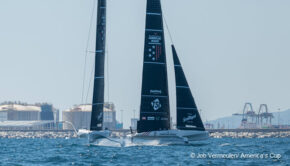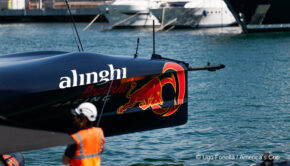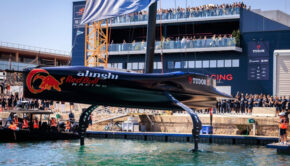COMMENTARY: Take a Closer Look… It’s the Future You See
Published on April 3rd, 2013
Marine industry professional David Barrow owns and manages Barrow International, a company dedicated to the distribution of marine products throughout Europe and the rest of the world. David is a frequent Scuttlebutt contributor, and below aims his focus on recent newsletter commentary…
—————
Former ISAF President Paul ‘The Pope’ Henderson appears to have hit many nails on the head in his recent comments. Let’s get back to basics, is essentially what he is saying; more young people, and less cost, oh how true that is. Mind you I never saw any white smoke coming from a chimney on the roof of ISAF’s offices on his consecration, unless it was coming from Paul’s ears.
Everyone says that they want more youth involved, but what are we really doing to support that initiative? For those that want it, the competitive squad systems are fine, but how many kids are burnt out on the way, and subsequently lose any love of the sport?
Most of the guys my age (don’t ask) never had a lesson, and we are all still dedicated to the sport. From the likes of Sir Robin Knox Johnston to the Lawrie Smith’s of this world, they all are self-taught and still sailing many decades later. Where will all of these squad trained sailors be in 40 years time… still in the sport, I’m not so sure?
If we do not imbue a love of sailing into the spirit of the next generations to come, we certainly cannot expect them to be lifers.
—————
Turning to the recent piece on the trickledown effect of the America’s Cup. I was really surprised to see that most of the supposed new technology described did not mention anything to do with the boat; it was more about policing the race course and media stuff. The real value to sailors and industry, in the longer term, will be more around the new composite systems developed, and design in wing structures. Believe me, you will be seeing a lot more wings on boats in the future; it is only a matter of time.
Time to open our eyes a little bit wider and see what is really unfolding here. Sailing, particularly at the higher end, spends a fortune on innovation and this spins out into our own environment, plus into wider commercial areas.
I recently attended a marine industry supply chain conference where one of the speakers was the Chief Executive of the Motor Racing industries Association. The speaker made one point at the start of his session that was obvious, once said, but the comment has rung in my ears ever since. My members, of the Motor Racing Industries Association, are not in the motor racing business, they are “in business”. He then went on to say that one member was now supplying radiator technology to fighter jets, another supplied light weight breaking systems to the military for desert warfare vehicles, etc., etc. Their starting place was in motor racing, but they had their eyes open for wider markets.
High level marine technology will always trickle down, and spin off into other areas. A lot of current mast, winch, deck hardware, standing and running rigging materials evolved in the rare air of high tech yacht racing, and is now standard on production cruising boats. The Kiwi’s developed techniques to build the first fiberglass 12 Meter, structural techniques that were passed down. Keel technology has also benefitted over the years. Harken, Lewmar, and Barton, to name but three ,supply to the windmill, architectural, telecoms markets, amongst others; technology that in many cases started in the America’s Cup theatre.
Incidentally, I saw a self tacking aerofoil sail built around an articulating frame this year. They have built one for a 38-footer now, and it works. The boat points higher, does not need rigging to hold the mast up, no winches, and is self balancing, so most of the time the mainsheet is slack. It is also reef able. It reaches faster than with a standard rig. As our understanding of low velocity aerodynamics to create thrust grows only more power can be generated.
Sails have gone from square sail canvas, to gaff cotton, to Bermudan cotton, to dacron, to mylar, to kevlar to carbon. Shapes have evolved; the wing is the ultimate shape. Who would have thought in the 60’s that we would now be making sails from plastic with a few fibres running through them some 50 years on.
The America’s Cup is what it is. You can love it or hate it each time it reincarnates itself, but there will be benefits to the sailing and maybe a broader world that we do not even know about yet.








 We’ll keep your information safe.
We’ll keep your information safe.